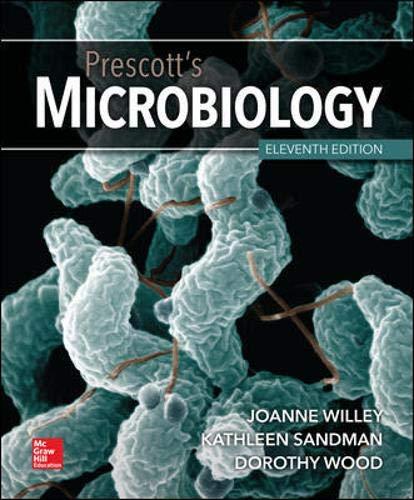
To determine: Whether the reaction that has a large negative
Introduction: Exergonic reactions are those reactions for which equilibrium constant is more than 1. Endergonic reactions are those reactions for which the equilibrium constant is less than 1.
To determine: The condition indicated about the equilibrium constant of the reaction.
Introduction: Exergonic reactions are those reactions for which equilibrium constant is more than 1. Endergonic reactions are those reactions for which the equilibrium constant is less than 1.
To determine: Whether the reaction will proceed rapidly to completion if displaced from equilibrium.
Introduction: Exergonic reactions are those reactions for which equilibrium constant is more than 1. Endergonic reactions are those reactions for which the equilibrium constant is less than 1.
To determine: Whether the free energy made available will be more or less.
Introduction: Exergonic reactions are those reactions for which equilibrium constant is more than 1. Endergonic reactions are those reactions for which the equilibrium constant is less than 1.
Want to see the full answer?
Check out a sample textbook solution
Chapter 10 Solutions
Prescott's Microbiology
- For a particular reaction, AH° = −16.1 kJ/mol and AS° = −21.8 J/(mol·K). Assuming these values change very little with temperature, at what temperature does the reaction change from nonspontaneous to spontaneous in the forward direction? OT= Is the reaction in the forward direction spontaneous at temperatures greater than or less than the calculated temperature? less than greater than Karrow_forwardOn the free energy diagram shown, label the intermediate (s) and transition state(s). Is the reaction thermodynamically favorable? Reaction.arrow_forwardOf the three thermodynamic quantities, enthalpy, free energy, and entropy, which provides the most useful indicator of spontaneity in a reaction? Explain.arrow_forward
- A particular reaction has a ΔG‡ of 37.0 kJ mol-1. In the presence of an enzyme, the same reaction has a ΔG‡ of 5.70 kJ mol-1. Calculate the value of ΔΔG‡ in kJ mol-1.arrow_forwardIf we alter the kinetics of a reaction by increasing Km but leaving Vmax alone, how will the L-B plot change?arrow_forwardConsider the analogy of the jiggling box containing coins that was described on page 85. The reaction, the flipping of coins that either face heads up (h) or tails up (T), is described by the equation h ↔ T, where the rate of the forward reaction equals the rate of the reverse reaction.a. What are ΔG and ΔG° in this analogy? b. What corresponds to the temperature at which the reaction proceeds? What corresponds to the activation energy of the reaction? assume you have an “enzyme,” called jigglase, which catalyzes this reaction. What would the effect of jigglase be and what, mechanically, might jigglase do in this analogy?arrow_forward
- Under what conditions might a reaction be endothermic but exergonic? Explain.arrow_forwardWhich of the following is TRUE under the following conditions: the enzyme concentration is 2.5 nM, substrate concentration is 75 nM, the KM = 150 nM, and the Vmax = 20 nmol/min a) The rate of the reaction is 20 nmol/min! b) The rate of the reaction is between 10 nmol/min and 20 nmol/min. c) The rate of the reaction is 10 nmol/min. d) The rate of the reaction is below 10 nmol/min. e) The rate cannot be determined from the above information.arrow_forwardConsider the following chemical equation whose delta(G) = 9kcal/mol: AC + BD ---> AB + CD what are the reactants and what are the products is this reaction spontaneous? How do you know? Is energy released or consumed by this reaction? If an enzyme, which catalyzes this reaction is added, what will happen to delta (G) If this reaction is coupled to another reaction, whose delta(G) is -12 kcal/mol, what will be the net delta(G) value? will the overall reaction be spontaneousarrow_forward
- In the reaction ATP + glucose → ADP + glucose-6-phosphate, ΔG° is -16.7 kJ/mol. Assume that both ATP and ADP have a concentration of 1 M and T = 25°C. What ratio of glucose-6- phosphate to glucose would allow the reverse reaction to occur?arrow_forwardCan the thermodynamic property Δ G° be used to predict the speed of a reaction in a living organism? Why or why not?arrow_forwardThe equilibrium constant for the reaction Q → R is 25. Solve, (a) If 50 μM of Q is mixed with 50 μM of R, which way will the reaction proceed to generate more Q or more R? (b) Calculate the equilibrium concentrations of Q and R.arrow_forward
 Human Anatomy & Physiology (11th Edition)BiologyISBN:9780134580999Author:Elaine N. Marieb, Katja N. HoehnPublisher:PEARSON
Human Anatomy & Physiology (11th Edition)BiologyISBN:9780134580999Author:Elaine N. Marieb, Katja N. HoehnPublisher:PEARSON Biology 2eBiologyISBN:9781947172517Author:Matthew Douglas, Jung Choi, Mary Ann ClarkPublisher:OpenStax
Biology 2eBiologyISBN:9781947172517Author:Matthew Douglas, Jung Choi, Mary Ann ClarkPublisher:OpenStax Anatomy & PhysiologyBiologyISBN:9781259398629Author:McKinley, Michael P., O'loughlin, Valerie Dean, Bidle, Theresa StouterPublisher:Mcgraw Hill Education,
Anatomy & PhysiologyBiologyISBN:9781259398629Author:McKinley, Michael P., O'loughlin, Valerie Dean, Bidle, Theresa StouterPublisher:Mcgraw Hill Education, Molecular Biology of the Cell (Sixth Edition)BiologyISBN:9780815344322Author:Bruce Alberts, Alexander D. Johnson, Julian Lewis, David Morgan, Martin Raff, Keith Roberts, Peter WalterPublisher:W. W. Norton & Company
Molecular Biology of the Cell (Sixth Edition)BiologyISBN:9780815344322Author:Bruce Alberts, Alexander D. Johnson, Julian Lewis, David Morgan, Martin Raff, Keith Roberts, Peter WalterPublisher:W. W. Norton & Company Laboratory Manual For Human Anatomy & PhysiologyBiologyISBN:9781260159363Author:Martin, Terry R., Prentice-craver, CynthiaPublisher:McGraw-Hill Publishing Co.
Laboratory Manual For Human Anatomy & PhysiologyBiologyISBN:9781260159363Author:Martin, Terry R., Prentice-craver, CynthiaPublisher:McGraw-Hill Publishing Co. Inquiry Into Life (16th Edition)BiologyISBN:9781260231700Author:Sylvia S. Mader, Michael WindelspechtPublisher:McGraw Hill Education
Inquiry Into Life (16th Edition)BiologyISBN:9781260231700Author:Sylvia S. Mader, Michael WindelspechtPublisher:McGraw Hill Education





